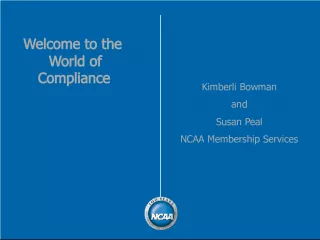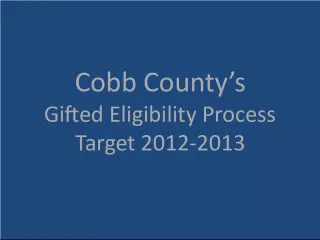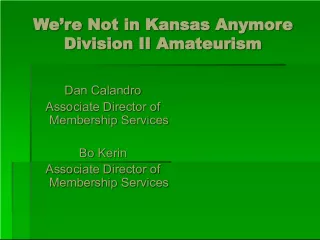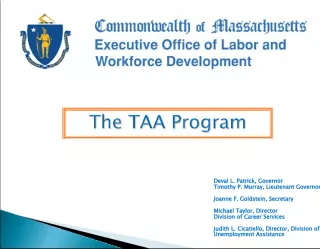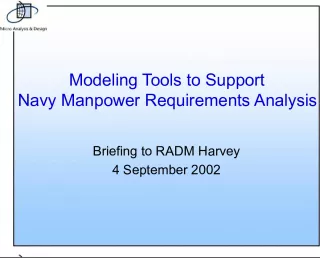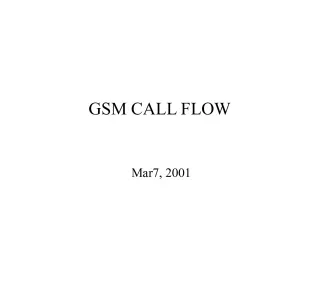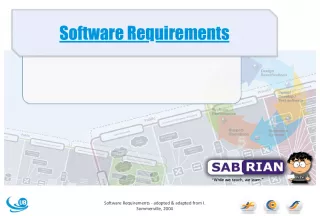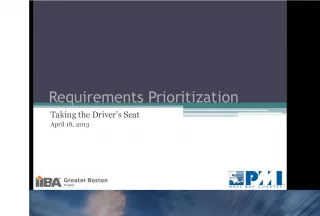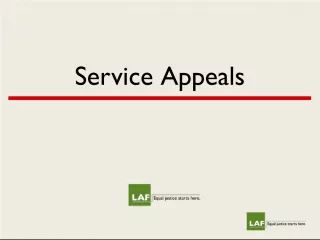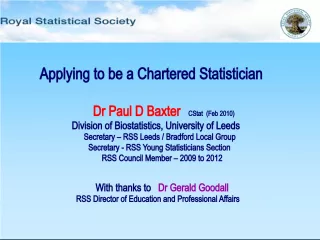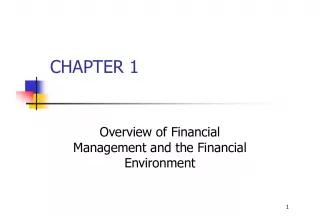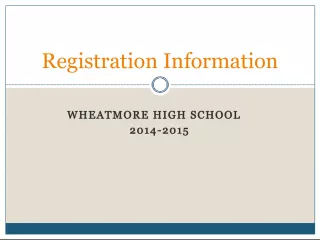NCAA Bylaw 14.3.4 Initial Eligibility Requirements Overview


This session covers the basics of initial eligibility for Division II student athletes, including core course requirements, GPA and test score requirements, and information on the NCAA Initial Eligibility Clearinghouse. Additionally, certification for student athletes entering college after August 1, 2007, is discussed.
- Uploaded on | 5 Views
-
 samu
samu
About NCAA Bylaw 14.3.4 Initial Eligibility Requirements Overview
PowerPoint presentation about 'NCAA Bylaw 14.3.4 Initial Eligibility Requirements Overview'. This presentation describes the topic on This session covers the basics of initial eligibility for Division II student athletes, including core course requirements, GPA and test score requirements, and information on the NCAA Initial Eligibility Clearinghouse. Additionally, certification for student athletes entering college after August 1, 2007, is discussed.. The key topics included in this slideshow are . Download this presentation absolutely free.
Presentation Transcript
1. Eligibility Division II Ellen Ferris & Stephanie Quigg
2. Session Overview Initial Eligibility Progress Toward Degree
3. Initial Eligibility NCAA Bylaw 14.3
4. Overview Basics. General elements of initial eligibility. Core-course requirements. Grade-point-average and test-score requirements. NCAA Initial-Eligibility Clearinghouse information. Additional certification for student-athletes entering a collegiate institution on or after August 1, 2007.
5. Initial Eligibility Prospective student-athletes (prospects) must meet established standards to: Practice; Compete; Receive institutional financial aid (including athletics aid). In Division II, all high school prospects must be certified by the NCAA Initial-Eligibility Clearinghouse.
6. Elements of Initial Eligibility Graduation from high school; Minimum number of core courses; Minimum core-course grade-point average; and Minimum score on either the SAT or ACT.
7. Division II Core-Course Breakdown (New Rule) 14 core-course rule. Three years English. Two years math (Algebra I or higher). Two years natural/physical science (one lab). Two years additional English, math or science. Two years social science. Three years additional courses (any area above or foreign language, nondoctrinal religion or philosophy).
8. Grade-Point-Average/ Test-Score Requirements Minimum core-course grade-point average of 2.000. Minimum SAT combined score of 820 or ACT sum score of 68. No sliding scale. No change with the increase from 13 to 14 core courses.
9. PROPOSAL NO. 9 INITIAL ELIGIBILITY TEST- SCORE REQUIREMENT STATE-ADMINISTERED ACT Intent: To specify that a state- administered ACT may be used to meet the initial-eligibility test-score requirement. Effective Date: Immediate. [Bylaws 14.3.1.3 and 14.3.1.3.2]
10. Determination of Initial Eligibility All prospects must register with the clearinghouse. Prospects are encouraged to register at the conclusion of their junior year. Clearinghouse will not process a transcript with fewer than six semesters. Register at www.ncaaclearinghouse.net (preferred method of registration). Register on paper form contained in the NCAA Guide for the College-Bound Student-Athlete.
11. PROPOSAL NO. 19 AMATEURISM GENERAL REGULATION VALIDITY OF AMATEUR STATUS PROSPECTIVE OR TRANSFER STUDENT-ATHLETE Intent: To require NCAA certification of the amateur status of any prospective student-athlete (including two-year and four-year transfers) initially enrolling at an NCAA Division II institution. Effective Date: August 1, 2006, for all final certifications for student-athletes enrolling at a Division II institution on or after August 1, 2007. [Bylaws 12.1, 14.01.3 and 21.7.6.5.2]
12. Progress Toward Degree Bylaw 14.4
13. Overview Basics. 12/24-hour rule. 75/25 rule. Six-hour requirement. Designation-of-degree program. Grade-point-average requirements. Exceptions and waivers.
14. Progress Toward Degree (PTD) Page Nos. 123-128 in the 2005-06 NCAA Division II Manual. Governs eligibility for competition only. Eligibility for practice and financial aid is determined by other NCAA, conference and institutional regulations.
15. Good Academic Standing Determined by institutional academic authorities for all students. Use the more stringent of NCAA, conference or institutional rules.
16. Case Study: Good Academic Standing In 2005-06, Marcus attended his first year at Esplanade University. At the end of the academic year, he earned a 1.575 grade-point average. Minimum institutional grade-point average for good academic standing is 1.500. Minimum conference grade-point average for good academic standing is 1.600. Is Marcus in good academic standing?
17. Answer Marcus needs a 1.600 GPA, but only has a 1.575 GPA. He needs the higher of NCAA, conference or institutional GPAs. Marcus is NOT in good academic standing. No competition for Marcus during the 2005-06 academic year.
18. PTD Does the student-athlete meet good academic standing? If no, no further analysis is required. If yes, then ask Did the student-athlete trigger PTD? If yes, then ask
19. PTD Triggers One academic year in residence at the certifying institution; OR Season of competition used at the certifying institution; OR Midyear transfer (not enrollee) to the certifying institution.
20. Case Study: PTD Triggers Sarah initially enrolls fall 2005 as a full-time student. She does not return for the spring semester. Sarah practices in volleyball fall 2005, but does not compete. Sarah wants to return to Claiborne State University fall 2006. Is Sarah subject to PTD requirements fall 2006?
21. Answer Sarah did NOT complete a year in residence. She did NOT compete in volleyball. She was NOT a midyear transfer. Therefore, Sarah is not subject to PTD requirements fall 2006.
22. Case Study: PTD Triggers Sarah played in a volleyball contest during fall 2005, but did not enroll for spring 2006. Will Sarah be subject to PTD fall 2006?
23. Answer Sarah did NOT complete a year in residence. She DID compete in volleyball. She was NOT a midyear transfer. Therefore, Sarah is subject to PTD because she triggered the season-of- competition element.
24. Case Study: PTD Triggers Wade was a qualifier. He attended Pitt Community College fall 2005 and transferred to Girod University spring 2006. Wade did not meet the two-year college transfer rule. Will Wade be subject to PTD fall 2006?
25. Answer Wade did NOT complete a year in residence at Girod University. He did NOT compete in basketball. He IS a midyear transfer. Therefore, Wade is subject to PTD because he triggered the midyear-transfer element.
26. Summary If a student-athlete triggers one of the three elements (academic year in residence, season of competition or midyear transfer), he or she is subject to PTD. Make sure the student-athlete is in good academic standing.
27. 12/24-Hour Rule Averaging method : Complete an average of 12-semester or quarter hours for each of the previous terms enrolled. Actual method : Complete 24-semester or 36-quarter hours since the two preceding regular semesters or three quarters. [Bylaw 14.4.3.1-(b)]
28. Case Study During 2004-05, Heather earned 27 credit hours over two semesters. During fall 2005, she earned 12 credit hours. Heather enrolled part-time spring 2006 and earned 10 hours. Heather earned a total of 49 credit hours. Does Heather meet the 12/24-hour rule?
29. Heathers Academic Grid Fall Spring Total 2004-05 13 14 27 hours 2005-06 12 10 22 hours
30. Answer Heather did not earn 24 credit hours during 2005-06. She does not meet PTD using the actual method. 2005-06: 12 (fall) + 10 (spring) = 22
31. Answer However, Heather earned an average of 12.5 hours per semester. She meets the 12/24-hour rule using the averaging method. 2004-05 = 27 hours 2005-06 = 22 hours 49 hours total 49 hours/4 semesters = 12.25
32. Part-Time Hours A student-athlete may not use part-time hours earned prior to initial, full-time enrollment at the certifying institution to satisfy both the initial-eligibility (or transfer requirements) and the PTD requirements. Part-time hours earned prior to initial, full-time enrollment may only be used for one certification at the institution. [NCAA Official Interpretation (Reference: 7/25/05)]
33. 75/25 Rule At least 75 percent of the required hours must be earned during the regular academic year. Not more than 25 percent of the required hours may be earned during the summer. J-term or mini-term hours count in the 75 percent, as long as the term ends before commencement. [Bylaw 14.4.3.1.2]
34. Case Study: 75/25 Tony enrolled full time and earned 17- semester hours as a freshman 2005-06. He earned eight hours the summer after his first year. Will Tony be eligible fall 2006?
35. Tonys Academic Grid Fall Spring Summer Total 2005-06 9 8 8 25
36. Answer Tony earned a total of 25 credit hours for the 2005-06 academic year. However, Tony did not earn 75 percent of his hours during the academic year. Fall + spring = 17 hours 75 percent of 24 hours = 18 hours Tony will not be eligible fall 2006 .
37. Case Study: 75/25 Amy earned 28 credit hours during her first academic year at Calhoun State University, 2004-05. She earned 16 hours her second year, 2005-06, but earned 12 hours in the summer. Will Amy be eligible fall 2006?
38. Amys Academic Grid Only 16 hours during the 2004-05 academic year. But, 75/25 can be calculated cumulatively when using the averaging method. Fall Spring Summer Total 2004-05 12 16 0 28 2005-06 10 6 12 28
39. Answer Amy earned 44 credit hours during academic years combined. 25 percent of 48 hours = 12 Amy meets 75/25.
40. Case Study: 75/25 Tommy enrolled full time at Dauphine University and competed in soccer fall 2005. Tommy completed 15 credits fall 2005. Tommy decided to work instead of enrolling spring 2006. Tommy completed nine credits summer 2006. Will Tommy be eligible fall 2006?
41. Tommys Academic Grid Fall Spring Summer Total 2005-06 15 Not enrolled 9 24
42. Answer Tommy will NOT be eligible fall 2006. Tommy did not complete 18 credits during the 2005-06 academic year. Tommy triggered meeting 12/24 and 75/25 because he used a season of competition during fall 2005.
43. Six-Hour Requirement Student-athletes must earn six-semester or six-quarter hours of academic credit the preceding regular academic term in which the student-athlete has been enrolled full time at any collegiate institution. Effective after fall term 2005 for hours earned in that term and thereafter. [Bylaw 14.4.3.1-(a)]
44. Six-Hour Requirement The rule affects transfer students, continuing students and students first entering a collegiate institution on or after August 1, 2005. If a student-athlete repeats a course in which a satisfactory grade was initially achieved, the repeated course may not be used to satisfy the six-hour requirement. [Bylaw 14.4.3.3.7]
45. Six-Hour Requirement Transfers The six-hour requirement requires that the hours must be transferable degree credit for transfer students. [(Bylaw 14.4.3.1.1)] If a transfer student meets any of the 4-4 transfer exceptions set forth in Bylaw 14.5.5.3, the transfer student is subject to meeting six- semester or six-quarter hours of transferable degree credit from the previous full-time term.
46. Six-Hour Requirement Graduate or Post-Baccalaureate Students Graduate students are not subject to the six- hour rule per Bylaw 14.4.3.4-(d). A student-athlete who has graduated and is returning for their second baccalaureate degree is not subject to PTD requirements. [Staff Interpretation (Reference: 6/25/03, Item C)]
47. Six-Hour Requirement Exceptions Final Academic Year of Degree Program May use credit hours acceptable toward any of the institutions degree programs to meet the six-hour rule, provided the student-athlete is carrying the credits necessary to complete the degree program at the end of two semesters or three quarters. Cooperative Education and Study Abroad Program Student-athletes are not required to complete six hours of academic credit during any term(s) of enrollment in a cooperative education program or an institutionally approved study-abroad program.
48. PROPOSAL NO. 30 ELIGIBILITY CHANGE IN ELIGIBILITY STATUS EXCEPTION Intent: To establish an exception to the certification of the six-hour term-by-term requirement for those institutions whose submissions or posting date of grades is within three days of the first day of classes of the following term; further, to require institutions that use this exception to provide the NCAA national office the number of student-athletes who are ultimately declared ineligible for the academic term but competed during the exception period. Effective Date: August 1, 2006. [Bylaw 14.1.10]
49. Case Study Six-Hour Requirement Tiffany enrolled full time at Iberville State College fall 2005. She earned 15 credits. Tiffany earned six credits spring 2006, and five credits summer 2006. Does Tiffany meet the six-hour requirement to be eligible fall 2006?
50. Tiffanys Academic Grid Fall Spring Summer Total 2005-06 15 6 5 26
51. Answer Tiffany meets the six-hour requirement. Fall 2005 is the last full-time term she attended. She earned 15 credits fall 2005.
52. Case Study Six-Hour Requirement Scott plays baseball and enters his final academic year at Napoleon University in 2005-06. Fall 2005 he enrolls in 12 credits, but only four credits are degree applicable. The institution offered a limited number of advanced classes in Scotts degree program fall 2005. Scott will graduate after spring 2006. Will Scott meet the six-hour requirement to be eligible to compete spring 2006?
53. Answer Yes. Scott meets the six-hour requirement under the exception for the final academic year of the degree program. Scott is in his final academic year (i.e., final two semesters) of his designated degree program. He is carrying (for credit) the courses necessary to complete the degree at the end of the two semesters. [Bylaw 14.4.3.1.5.1]
54. Designation of Degree Student-athletes must designate a degree program by beginning of third year of full-time collegiate enrollment. Fifth semester or seventh quarter. After degree is designated, all credits must count for that designated degree for purposes of 12/24.
55. Hours Earned for Degree Credit During the first-two years of enrollment, a student-athlete may use credits acceptable toward any of the institutions degree programs. [Bylaw 14.4.3.1.4-(a)]
56. Case Study: Degree Credit Courtney completed her second year at Rampart College. She earned 30 hours in sociology. She also liked education, so she took 18 credits. Courtney has not yet declared a major. For purpose of 12/24 and the six-hour requirement, what degree program do her credits count toward?
57. Answer During the first two years the credits can go toward any institutional degree program until the student-athlete declares a major.
58. Change of Degree Appropriate academic authorities must document a change of degree. Credits earned before the change count toward the first degree program. Credits earned after the change count toward the new degree program.
59. Grade-Point Average A student-athlete must present a minimum cumulative grade-point average: 1.800 after earning 24-semester or 36- quarter hours; 1.900 after earning 48-semester or 72- quarter hours; 2.000 after earning 72-semester or 108- quarter hours and thereafter.
60. Grade-Point Average Based on the method of calculation used by the institution for all students; and Includes all coursework normally counted by the certifying institution in calculating the grade-point average.
61. Case Study Grade-Point Average In 2005-06, Jake attempted 25 credits at Basin State University. However, he only earned 22 credits. Jake earned a 1.785 cumulative grade-point average. Does Jake meet the grade-point average requirement?
62. Answer Jake did not trigger meeting the grade- point-average requirement. The application of the minimum grade-point- average requirements is based on the number of credits earned by a student- athlete, as opposed to the hours attempted. [Official Interpretation (Reference: 10/15/04)]
63. Other PTD Issues Does Jake have other PTD issues? Yes. Jake only earned 22 credits in 2005- 06. He is deficient in meeting 12/24. Basin State University may want to file a PTD waiver on Jakes behalf.
64. Case Study: Grade-Point Average Paula has been enrolled for three years and earned 70-semester hours. At the end of her third year in 2004-05, she has a 1.950 grade-point average. Entering spring 2006, Paula has earned 84-semester hours. Is Paula subject to meeting the 2.000 grade-point- average requirement?
65. Answer No. Paula is not subject to meeting the 2.000 grade-point-average requirement. The grade-point-average requirement is not reviewed on a term-by-term basis. A student-athlete is eligible for the entire academic year once he or she is certified under PTD. Exception: Six-hour requirement.
66. Grade-Point Average If an institution requires multiple minimum grade-point averages for graduation (e.g., cumulative, major, institutional), a student-athlete must fulfill the required minimum grade-point average for PTD requirements using only the cumulative grade-point average. [Official Interpretation (Reference: 8/24/05)]
67. Exceptions and Waivers Missed-term exception. Midyear enrollee exception. Nonrecruited, nonparticipant exception. Two-year nonparticipation exception. Medical absence waiver. [Note: Exceptions on campus; waivers to NCAA.]
68. Missed-Term Exception One time during a student-athletes entire period of collegiate enrollment. May be used to prorate 12 hours per term in order to meet 12/24 under the averaging method only. Student-athlete must miss a complete term or consecutive terms during an academic year. Student-athlete must have been eligible for enrollment during the absence. At the time of certification, the student-athlete must have fulfilled PTD requirements for the terms in which the student-athlete was in attendance.
69. Midyear Enrollee Exception Prorate at 12 units per term during the initial academic year of attendance for student-athletes entering midyear. Note: Midyear transfers trigger PTD and must earn 24 or 36 credits prior to the next academic year even though they have only been enrolled one term at the certifying institution.
70. Nonrecruited, Nonparticipant Exception Exception for the initial season of eligibility. Student-athletes must meet the following conditions: Residence for at least one academic year; Not recruited; Not received athletically related financial aid; Never practiced or participated in intercollegiate athletics; and Otherwise eligible under all institutional, conference and NCAA rules.
71. Two-Year Nonparticipation Exception Consecutive two-year period immediately before the date on which the student begins participation; the student-athlete has not participated in countable athletically related activities in any sport in intercollegiate competition; OR Has not participated in organized- noncollegiate amateur competition while enrolled as a full-time student in a collegiate institution.
72. Medical Absence Waiver Prorate 12 units per term during an academic year when a student misses a term or is unable to complete a term as a full-time student as a result of an injury or illness. Administered by the conference.
73. PTD Waivers Cases heard by the NCAA Division II Academic Requirements Committee Subcommittee on Progress-Toward- Degree Waivers. Teleconferences held biweekly. Subcommittee decisions may be appealed under specified conditions.
74. Tips for Filing a Waiver Submit waiver to NCAA at least three weeks prior to the student-athletes competition. Use the most recent application form. If submitting at end of term, attach grades for that term. If student-athlete is learning disabled, attach medical documentation.
75. Tips for Filing a Waiver Documentation required for cases involving misadvisement. If a student-athlete does not meet the one-time transfer exception due to not meeting PTD requirements at the first institution, a waiver may be requested by either the first or second institution, even if the divisions are different.
76. Frequently Asked Question Q: When a change in eligibility occurs at the end of a term, when can you officially designate a student- athlete eligible or ineligible? A: The earliest date a student-athlete may become ineligible is the day after the date of the last scheduled examination as listed in the institutions official calendar. The latest a student can become ineligible is the first day of classes for the following term. [Bylaw 14.1.9]
77. Session Overview Initial Eligibility Progress Toward Degree
78. Questions?
